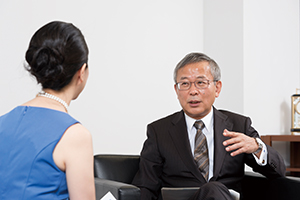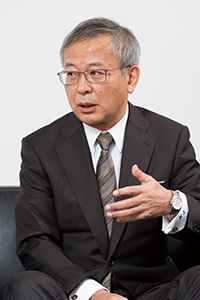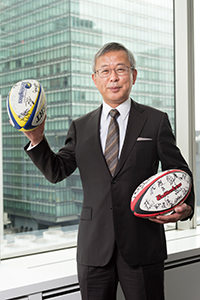 |
|
|
|
|
|
View from the Top Vol. 14, No. 1, pp. 1–5, Jan. 2016. https://doi.org/10.53829/ntr201601tp1  Creating New Value with a Spirit of One for All, All for One—Using Human Sensitivities to Popularize ServicesOverviewThe NTT Group has taken up the challenge of self-transformation toward growth in profits as declared in its Medium-Term Management Strategy “Towards the Next Stage 2.0.” There are high expectations of the NTT Group for technological development and social contributions in fields of great global interest such as artificial intelligence, Internet of Things, and cybersecurity. At the dawn of a new year, we asked Senior Executive Vice President Hiromichi Shinohara to tell us about NTT Group plans for 2016 and specific initiatives for creating new value. Keywords: R&D, artificial intelligence, cybersecurity 2015: NTT Group makes a big turn from a main player to a catalyst—Mr. Shinohara, what kind of results were obtained last year under the new Medium-Term Management Strategy? To begin with, the entire NTT Group has endeavored to change its mindset. We have abandoned our sense of being a “main player” and have put ourselves on the path to becoming a “catalyst.” The NTT Group announced this change in direction in its Medium-Term Management Strategy “Towards the Next Stage 2.0” presented in May 2015. There are two main pillars to this strategy. One is self-transformation with the aim of becoming a “value partner” and increasing profits. The other is further promotion of the business-to-business-to-X (B2B2X) model and the opening up of new business fields and markets. One example of self-transformation is the launch of the Hikari Collaboration Model by NTT EAST and NTT WEST. This model involves wholesaling of optical-fiber access services and has enabled us to start providing new value to our customers in cooperation with many partners other than telecom carriers. More developments are needed here, but we have gotten off to a good start. In tandem with these efforts, NTT research and technology development has been focused on improving cost efficiencies by simplifying the network and preparing technologies essential to new services in the form of standardized “engines.” In addition, we pursued collaboration and open innovation with group companies and various partners. One example is the functional fabric called “hitoe” that can provide biomedical information simply by wearing it. In December 2014, NTT DOCOMO launched a fitness service using hitoe called “Runtastic for docomo,” and not to be outdone, NTT Communications began tests of a safety management system in which staff of major corporations such as the construction firm Obayashi and Japan Airlines are asked to wear hitoe material in the field. NTT DATA, moreover, is working on using hitoe as a real-time tool for measuring the condition of drivers in IndyCar racing in the United States, and studies are also underway on the use of hitoe for measuring the heart rate and myoelectric signals of pilots in the jet fighter test environment of Japan’s Ministry of Defense. Indeed, the possible applications of hitoe have expanded greatly this last year. As a result of these activities, I think I can safely say that this past year marked a major turn for the entire NTT Group in a new direction based on the keyword “collaboration.” —A huge amount of energy would be needed to move such a massive organization as the NTT Group. How do you keep everyone and everything in step? When determining to move in the direction of new value, I think there are two ways to go about it. One is to get everyone moving after giving instructions on what needs to be done, and the other is to get everyone moving by sharing an awareness of the problem and an understanding of the objective. Sometimes I feel that giving instructions is important, but I also think it’s important that I get everyone to empathize with the NTT Group objectives and way of thinking and to think about the best way of dealing with problems that we will have to confront from here on. For example, I have begun summoning those in charge of technology development at the various group companies to share each other’s research and development (R&D) plans and to discuss what should be developed in common. Here, with an eye to creating new services and accelerating the generation of profits while eliminating waste in technology development, we looked for technologies that could be shared by group companies. These efforts have been producing results. I believe that experiencing such a string of successes leads to ongoing, self-motivated activities within the NTT Group.
Linking people and technology to create new value—How do you plan to expand upon last year’s efforts? One way is to make an all-out effort to create new value to drive the growth of the NTT Group. Here, I would like to accelerate the development of a B2B2X model. Moreover, from the viewpoint of R&D, stepping up the standardization of engines (technologies) is important. Last year, for example, the NTT Group announced a variety of interactive, talking robots typified by one named “Sota.” These robots incorporate advanced technologies for natural-language processing and other functions, but up to now, they have been independently developed and supported. This approach, however, incurs unnecessary expenses and slows down the development process, so from here on, I would like to further promote the standardization of technologies. Another way is to accelerate “hybrid development.” Up to now, we have been creating better services by promoting joint development with NTT Group companies, but this year, I would like to accelerate the speed of providing services to the market from the research stage. To this end, I will promote joint activities from early on and target market needs for development. I would also like to envision those parts of a service that customers may not be aware of in the present and incorporate those parts in development projects. Thus, in addition to simply doing something because we are asked to do so by customers, I would like to improve our competence at predicting future needs and responding accordingly. We need to look into the future and move forward in the present. To begin with, I would like all of us to develop those ways of thinking! Regarding the network business, our goal was conventionally to achieve higher levels of quality. However, considering today’s customer needs, the network must be simplified, and the cost efficiency of operations and maintenance must be improved to increase the profits of the entire NTT Group. To this end, NTT announced the future network vision “NetroSphere” in February last year, and since then, we have been steadily forming business relationships, so I would like to make this year one for implementing this concept in tangible ways. I would also like to channel the results of development projects done at NTT Innovation Institute, Inc. (NTT I3) to specific market needs in order to generate profits in global cloud services. To push this along, I would like to deepen the ties between NTT I3 and NTT laboratories on the Japan side. —How do you approach the fields of AI, IoT, and cybersecurity, today’s top keywords? Supercomputer performance, which at one time was available to only a few people, is today achieved in smartphones, which many people now take for granted as a tool they can use in the palm of their hand. Advances in technology are truly amazing, but they do not always translate into better lives for people. As for artificial intelligence (AI), it has not yet reached a level that can truly transform society. In addition to making society more efficient and convenient for people, I would like to see AI play a role in achieving a prosperous society by helping to make the lives of many people enriching and fulfilling in the true sense of the words. Details on our AI initiatives will be announced at the NTT R&D Forum in February 2016, but we can broadly divide them into four areas. These are Agent AI that does things for people, Ambient AI based on massive amounts of data in relation to Internet of Things (IoT), Network AI that links to networks, and Heart-Touching AI that interacts with people in a human-friendly way. Going forward, we will continue to pursue ways in which AI can be beneficial for our lives. Next, as for IoT, there will be various requirements depending on the application field. This year, I would like to produce concrete examples of IoT applications in collaboration with partners. Data will become of prime importance in this endeavor. However, data involves not only machines but also individuals and their personal attributes, so care must be taken in how to obtain data from people, in how to safely use and combine that data, and in how to otherwise apply that data in an appropriate manner. In addition, it’s not just technology that matters here but also the creation of new value from collected data. I therefore believe that gathering data in a divided “silo-type” manner is not enough, and that it will become increasingly important to coordinate different types of data in some way. In terms of cybersecurity, we plan to build up our training program for security personnel in the NTT Group, and we aim to establish a security force on the scale of about 10,000 people within Japan by 2020. Last year, we completed our first round of certifications for security qualifications and we will continue to develop ourselves in this area. However, when thinking ahead to 2020, it’s not only telecom carriers but all operators involved with critical infrastructure that must address the need for robust security measures. Today, just about everything including manufacturing plants and rail transport is connected to the network, so security measures constitute an investment for future growth and a major management issue. All companies and enterprises must identify what needs to be protected within their operations and must examine their ability to ensure security. With this in mind, NTT established the “Cross-Sector Cybersecurity Forum” in June of last year to contribute to the training of security personnel in Japan and to promote information sharing. This forum has so far enabled more than 40 participating companies to introduce their efforts in developing security personnel, present training case studies, exchange ideas and opinions, and talk about each other’s state of security. In this way, each company can reexamine the problems they are facing and consider appropriate solutions. Even companies that had thought they were doing okay when it comes to security have come away from such gatherings with a heightened sense of danger and a resolution to enhance their security measures. This year, I would like to promote the sharing of security-related information with global telecom carriers and to deepen our interaction with them. Finally, as an example of activities toward 2020, we gave proof of concept (PoC) presentations on some of our R&D results at last year’s NTT R&D Forum. At this year’s forum, I would like to connect PoC to actual applications and specific ways of achieving them together with attendees. To this end, the ability to convey things to people with a richer level of expression will become necessary, so I think that collaboration with people who have highly developed senses, have extensive experience, and are sensitive in nature will become important from here on. In particular, when introducing foreigners to Japanese culture, we must keep in mind that “every man knows his own business best.” At NTT, technology is our business, but there are people that are considerably more knowledgeable, experienced, and emotionally equipped to convey the diverse aspects of culture. Certainly a richer level of expression can be achieved by tapping the abilities of professionals and people directly involved with culture.
Importance of resolution and effort in popularizing a new development—Mr. Shinohara, can you leave us with a message for all employees in the NTT Group? I would be happy to. This is the year that the true worth of collaboration will be put to the test. Collaboration is a summation of individual strengths. It is a natural tendency to do what we are capable of doing and to rely on others to do what we cannot. We should have the courage to refrain from doing some things even if we feel we can do them on our own. There are also times when we need to discard some things in our quest to create something strong and lasting. This is a matter of self-discipline. To this end, I would like us to build relationships with partners in which conversations can be held on an equal footing. This may sound easy, but it’s actually difficult; an equitable relationship is inherently unstable. But I would like everyone to keep this goal in mind. In addition, we need to remember that developing something new must be accompanied with efforts to spread and popularize that new technology or service. Here, the resolution and effort required to popularize something new is different from that needed to develop it. Leaving one’s mark on society is truly a good feeling. I would like to ask each and every employee to think about the best way of popularizing a service that we have developed that has something to offer society. In a sense, the word “universal” is similar to “popular,” but giving an existing thing value to make it universal is different from discovering something that is universal in a new way. Wouldn’t this challenge of searching for universality be interesting? Considering that we may spend about 30 years in the workplace, it is impossible to keep up a winning streak throughout that time. There are times when we inevitably have to lose. Instead of being focused on winning or losing, I would like everyone to think hard on what the company and society at large should be like. If we attempted 100 development projects and failed 90, instead of dwelling on the 90 failures, we can say that this is a process that gave birth to 10 successes. Moreover, from the viewpoint of the entire NTT Group, it can be said that a failure in one division sometimes leads to a success in another. Failure is evidence of great effort. Let’s take up the challenges of R&D without fear. By the way, rugby, which is famous for its “one for all, all for one” spirit, is growing in popularity thanks to the success of the Japanese national team in the Rugby World Cup last year. I believe that people felt the power of a team in addition to the power of individual players. Let’s think of the entire NTT Group as a team and let’s venture into the new era together.
Interviewee profileCareer highlightsHiromichi Shinohara joined Nippon Telegraph and Telephone Public Corporation (now NTT) in April 1978. In 1998, he was promoted to Vice President of the Information Sharing Laboratory Group at Access Network Service Systems Laboratories. He became Senior Vice President of the Information Sharing Laboratory Group in June 2007. In June 2009, he became a member of the Board of NTT and Head of the R&D Strategy Department. In June 2012, he became Executive Vice President and Head of the R&D Strategy Department. He took up his present position in June 2014. |
|











